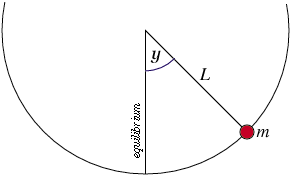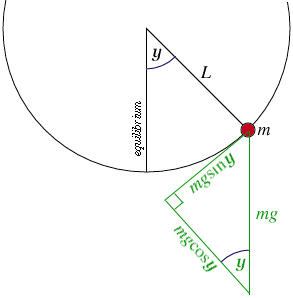Initial Value Problem Applications - The Simple Pendulum
Applications of Differential Equations
The Simple Pendulum
Theoretical Introduction
Our problem in this laboratory involves the derivation and analysis of the equation governing the position of a pendulum as a function of time.
A simple pendulum is one which has a weightless, stiff bar and experiences no friction. All of the simple pendulum's weight is thought of as being concentrated in it's bob. As usual we are oversimplifying the real problem in order to be able to properly see its essential components.
Before we can derive an equation that gives us the position of the pendulum as a function of time we must first decide upon a coordinate system to use. It may seem that the usual xy-system might be useful here, but think again. Our task is to find position as a function of time. If the position itself is given by two coordinates, x and y, then we'll end up with a problem involving three variables--x, y, and t for time. If we can avoid this, we would be better off. After all, two variable problems can be bad enough, without making things worse.
So what should we use to track the pendulum bob? Mathematicians would describe the pendulum as a system that only exhibits one degree of freedom. What they mean by this is that due to the pendulum's bar, the bob can't really be anywhere other than stuck on the end of the bar. The bar acts as a restricting factor in the life of the pendulum, reducing its "freedom" to move around wherever it likes. A position with only one degree of freedom can be expressed in terms of a single variable.
An Analogy: When a vehicle such as a ship moves around on the surface of the Earth, what do we use to describe its position? You should have heard of longitude and latitude. But hold on a second. The ship is a three dimensional object moving around in three dimensional space. As such, shouldn't we be using three variables to describe its position, say longitude, latitude, and height? No! This isn't necessary since since the ship's motion is restricted to the surface of the Earth. Two variables are sufficient in locating the ship because it only has two degrees of freedom.
Likewise our pendulum has only one degree of freedom, so only one variable is needed to give its position. Taking our cue from the example of navigating a ship, it doesn't take a great leap of genius to realize that the pendulum's position might be described in terms of the angle it is displaced from some reference angle. We'll use the rest position of the pendulum, straight down, as our reference angle, an angle of zero radians. Positions counter-clockwise from here will be considered positive angles, and clockwise positions will be given negative angles.
With me still? So the two variables we'll use in this problem will be time, denoted by t, and measured in seconds, and the angle that the pendulum makes with the straight down rest position, denoted by y, and measured in radians. At this point we'll also introduce a couple of constants: we'll take the length of the pendulum to be L meters, and it's mass to be m kilograms.
Pictorially we have this so far:

Now that we've chosen our variables we start to look for the pendulum's equation. As usual with physics based problems the derivation depends upon an analysis of the forces involved in the system.
Tangential Force
We're going to look at the tangential force upon the pendulum bob from two different points of view.
Angular Acceleration: This is the acceleration that the central angle experiences with the passage of time. As usual with acceleration, it can be found by taking the second derivative of the distance, or in our case the second derivative of arclength. The angle in our analysis has been named y, but this is not the same as arclength (unless you're working on a unit circle, i.e. a pendulum with bar of length 1 m). So how can we get the arclength if we know the angle? The answer goes all the way back to the definition of radian measure. By definition, if y is measured in radians, then:
y = s/L
which can soon be rearranged to give:
s = L y.
As we said a few seconds ago, acceleration is found by taking the second derivative of arclength. Applying the second derivative to the last equation gives us:
s″ = L y″.
(Remember, L is the bar-length, so it's a constant.) If we replace s″ by its other name, acceleration, or a, we get:
a = L y″.
Almost there now. We have the angular acceleration, but we said we needed to look at the forces involved. Mathematically, how does one get force from acceleration? The answer comes immediately from Newton's Second Law of Motion, which in its most condensed form says F=ma. So to get the tangential force from our last equation we would need to multiply it by m on both sides. Doing this gives us:
m a = m L y″,
which immediately becomes:
F = m L y″,
thanks to Newton. So we now have one version of the tangential force experienced by the pendulum bob.
Gravitational Acceleration: the other way of deriving the tangential force on the pendulum bob is to consider the affect of gravity directly. Since gravity pulls straight down, not all of its force is felt in the tangential direction of the pendulum's motion. But we're after the tangential force so that we can form a relationship with our last equation above. To get this we'll have to look for the tangential component of gravity. This can be found by projecting gravity's force vector, mg, orthogonally onto the tangent line to the curve, as shown in the picture:

Note that the lower angle can also be labelled y since the orthogonal line of projection is parallel to the pendulum's bar, meaning that the upper and lower angles are opposite interior angles of a parallelogram, and therefore necessarily equal. The sides of the lower triangle can soon be labelled, using a little right triangle trigonometry, as shown.
So there we have it, another name for the tangential component of force is, from our picture:
F = -m g sin(y).
The force being negative in this case due to its tendency to move the pendulum bob back towards the equilibrium position. Anyway, there's our other version of the tangential component of force.
Equating the Forces
Now we get the pay-off for the work we did deriving the tangential component of force in two different ways. From our angular acceleration work we have:
F = m L y″,
and from our gravitational acceleration work we have:
F = -m g sin(y).
These can be equated to give us:
m L y″ = -m g sin(y).
Dividing both sides by m L gives us:
y″ = -(g/L) sin(y),
and moving the right hand side over to the left we get:
y″ + (g/L) sin(y) = 0.
This is the equation we were seeking all along--the differential equation governing the motion of the simple pendulum. Now we'll look at how we can solve this differential equation using the computer. Let's move on and see how we can implement these ideas in Mathematica.
 Nonlinear versus Linear Pendulum MAIN DEMO
Nonlinear versus Linear Pendulum MAIN DEMO







